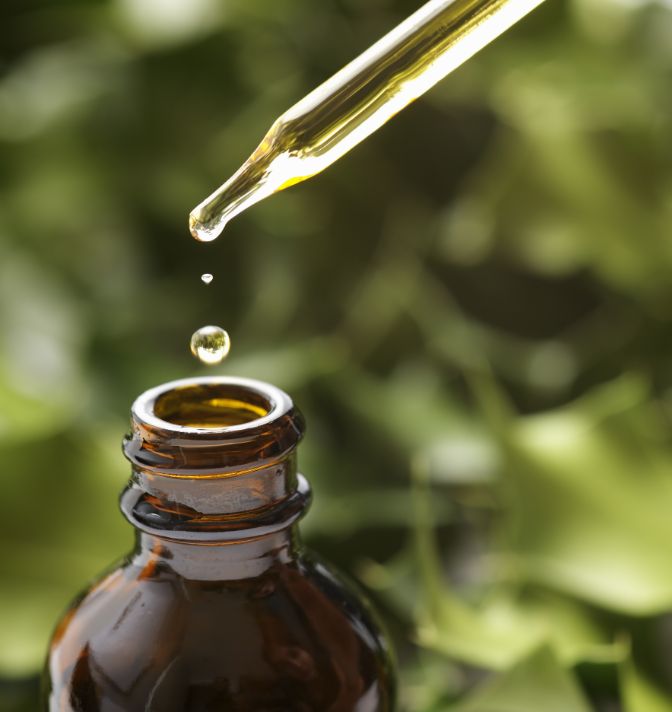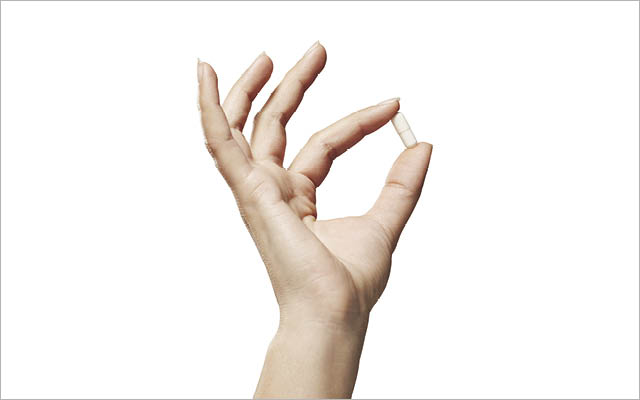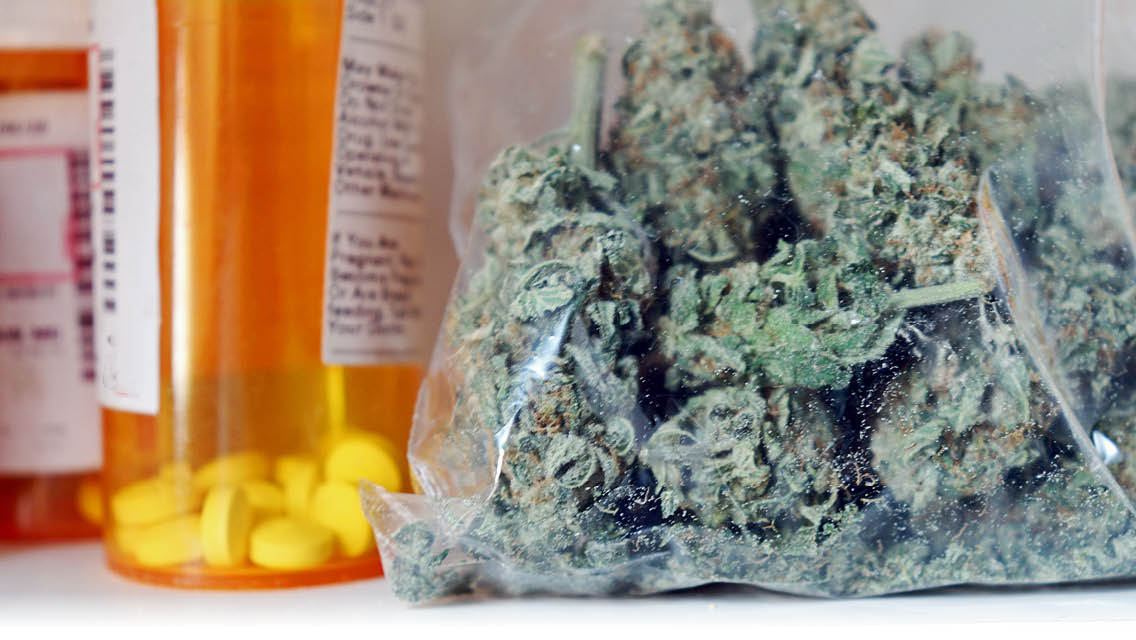Explore this article:
The Endocannabinoid System | CBD Versus THC | The Entourage Effect | Choosing the Right CBD | Determining the Ideal Dose
How Effective Is CBD for . . . ?
Epilepsy | Anxiety | Digestive Disorders | Cancer | Pain
When Jessica Smith (not her real name) began taking anxiety medication, it relieved her symptoms but came with some unwelcome sexual side effects like decreased libido.
A 38-year-old writer and theater artist in Minneapolis, Smith took the pills after a traumatic event triggered symptoms of PTSD, including insomnia, a racing mind, loss of appetite, and weight loss. After a year, she halted the meds, and her anxiety symptoms returned. She struggled to fall asleep and stay asleep — and when she did doze, she suffered nightmares.
Then she heard about the health benefits of a plant-derived compound called cannabidiol, or CBD.
“I picked up a bottle and took a dose under my tongue right before bed,” Smith recalls. “Within 20 minutes, I noticed my racing mind quieting. It also helped with my sleep.”
She used CBD nightly for a few months, until her anxiety waned; then she took it about once a week.
“The thing about CBD is that, unlike traditional anxiety meds that you have to take daily, you can just take it when you need it,” she says. “I feel like I have more control, and I’ve had no other side effects.”
Smith’s experience is not unique. Substantial anecdotal evidence suggests that CBD is a safe and effective remedy for a wide variety of conditions, including anxiety, chronic pain, and autoimmune disorders — and the scientific research to support it continues to grow.
The Endocannabinoid System
To understand CBD, it helps to first understand the human endocannabinoid system, or ECS. This complex system involves signaling molecules called endocannabinoids (which the body produces), their receptors, and a handful of enzymes that synthesize and break down the molecules.
The ECS is a fairly recent discovery. Researchers identified it in the 1990s when, while exploring the physiological effects of cannabis, they noticed endocannabinoids interacting with the same receptors as the cannabis molecules.
Cannabinoid receptors exist throughout the body: in the brain, gastrointestinal tract, reproductive system, heart, blood cells, muscles, and elsewhere. The body’s own endocannabinoids engage with these receptors to affect a wide range of physiological functions, including appetite, memory, movement, and pain.
The ECS is responsible for two basic activities, explains Michael Moskowitz, MD, author of Medical Cannabis. The first is modulating energy and well-being. The second is nudging the body back to homeostasis in the face of stress, injury, or disease. Because of this governing role, the ECS is sometimes referred to as the “master regulatory system.”
In her book, Healing With CBD, Eileen Konieczny, RN, cites the work of endocannabinoid researcher Robert Melamede, PhD, and writes, “You can think of the ECS as the taskmaster that is constantly multitasking, adjusting, and readjusting the complex network of molecular thermostats that control our physiological tempo.”
“The ECS is more responsible for maintaining balance and health than any other system,” Moskowitz notes. “We’re still learning about the full extent of its function, but we’re beginning to understand that the ECS is the most important system for controlling disease in the animal kingdom.”
CBD Versus THC
Enter CBD. The Cannabis sativa plant species, which includes both hemp and marijuana, contains at least 113 known phytocannabinoids, chemical compounds that mimic and stimulate the endocannabinoids that are naturally produced by the human body. The two most abundant phytocannabinoids are also the most studied: tetrahydrocannabinol (THC), which produces the intoxicating effects typically associated with cannabis, and cannabidiol (CBD).
THC and CBD are present to varying degrees in both marijuana and hemp plants, along with a wide variety of phytochemicals, including other cannabinoids, flavonoids, and terpenes. These molecules give certain strains of cannabis their unique therapeutic and experiential properties, as well as a distinct aroma. Most strains of marijuana have more THC than CBD, while industrial hemp (used to make clothing, rope, and seed oils) contains only trace amounts of THC and a higher proportion of CBD.
CBD can be derived from both hemp and marijuana, but makers of any products that are nationally available will extract it almost exclusively from hemp. Hemp-derived CBD products are legally required to contain less than 0.3 percent of THC — far below a level that would deliver a high. Still, even hemp-derived CBD products may have enough THC to be detected by a drug test.
Unlike THC, CBD is nonintoxicating, though it does affect the brain in other ways. Evidence suggests it can ease anxiety, in part, by interacting with the brain’s serotonin and GABA receptors. One recent study found that a single 600 mg dose of CBD could reduce psychosis symptoms by modulating activity in relevant areas of the brain. In fact, when taken in conjunction with THC, CBD actually mitigates THC’s psychoactive effects.
THC directly interacts with the brain’s most common type of cannabinoid receptor, the CB1, which is what causes the high. CBD works differently. It interacts with CB2 receptors, which operate throughout the nervous and immune systems. (For more on THC and it’s ability to treat health conditions, such as chronic pain, glaucoma, and Alzheimer’s disease, see “THC as Medicine?“)
“These receptors are responsible for CBD’s pain-relieving and anti-inflammatory effects and play a role in autoimmune disorders and regulating blood sugar,” says integrative holistic physician Rav Ivker, DO, author of Cannabis for Chronic Pain. CBD also helps inhibit an enzyme that breaks down anandamide, one of the body’s endocannabinoids known as the “bliss molecule.”
Ultimately, CBD works by supporting the body’s own endocannabinoid system, explains integrative physician Robert Rountree, MD. “It enhances what should be working properly in the first place.”
(Go beyond CBD to explore other phytocannabinoids that can help you deal with anxiety, stress, inflammation, insomnia, PTSD, depression, and more at “Meet the New Phytocannabinoids.”)
The Entourage Effect
Whether sourced from hemp or marijuana, the CBD molecule is the same. But researchers are beginning to realize it doesn’t operate in isolation.
“It’s a mistake to focus on THC and CBD alone,” explains Rountree. “They are two chemicals out of hundreds in Cannabis sativa, and they all seem to work in concert with each other.”
This chemical collaboration is often referred to as the “entourage effect” or “ensemble effect.” Phytocannabinoids, such as cannabinol and cannabichromene, are anti-inflammatory agents, while cannabigerol has antibacterial effects. Still others (out of the 113 that researchers have identified so far) exhibit antispasmodic, antidiabetic, and antifungal powers.
“Each phytocannabinoid has its own properties,” explains Moskowitz. “They overlap in the conditions and symptoms they treat, but they each go about it in a unique way. That’s the synergistic effect — the sum of all the components working together is greater than the parts.”
In theory, “full-spectrum” or “whole-plant” CBD products contain the complete range of phytochemicals in the plant from which they were derived. But Moskowitz notes that these descriptors are unregulated: “‘Full-spectrum’ is a term with no standardization, and people throw it around,” he says.
Ideally, as phytocannabinoid research advances, the best labels for CBD products will indicate not just verified levels of CBD (and THC, when applicable) but other medically active cannabinoids as well. “It would be a major boon for people to understand that it’s more than just these two compounds,” says Moskowitz.
Rountree expects that researchers will begin to cultivate strains of Cannabis sativa plants to enhance specific phytocannabinoids and their particular therapeutic effects. “We’re putting so much emphasis on CBD right now that we forget there’s a whole range of phytocannabinoids and chemicals that regulate and affect the ECS,” he notes. “The future will be much more focused on the whole entourage.”
The entourage effect helps explain why some conditions, including pain and ulcerative colitis, seem to respond better to a combination of CBD and THC. But full-spectrum CBD without any THC still packs a therapeutic punch.
“You can receive all the anti-inflammatory effects of CBD and boost the endocannabinoid system without touching the psychoactive properties of THC,” says Tiffany Lester, MD, medical director of Parsley Health San Francisco.
Choosing the Right CBD
At this writing, CBD’s legal and regulatory status remains in flux, so consumers must proceed with caution. One 2017 review of 84 CBD products sold online found that nearly 70 percent published misleading claims about CBD levels. Some had more than the label suggested, others less. About 21 percent of the products contained some THC.
Reputable CBD manufacturers (such as Charlotte’s Web and CV Sciences) subject their label claims to third-party testing.
Finding products made with organically grown hemp is also critical. Hemp is a bioaccumulator, meaning it absorbs heavy metals and chemicals from soil. Those toxins can become concentrated in “medicinal” doses of CBD.
Although the market is bursting with CBD products, ranging from bath bombs to gummy bears, experts agree that, to maximize the therapeutic benefits, CBD is best approached and used as a medicine. Capsules, oral sprays, and edibles with clearly labeled levels of CBD are solid options if they’re offered by a reputable supplier.
Sublingual tinctures — with droppers that let you calibrate the dose to the milligram — provide the most dosage control. Look for a CBD oil delivered in a healthy fat, such as coconut or MCT oil.
Determining the Ideal Dose
“The key to using CBD effectively, as with any medicine, is consistency and dosage,” says Ivker, noting that determining the right dose often requires some experimentation. Because clinical research on CBD is in its infancy, most of what’s known about effective dosages is based on anecdotal evidence.
What little we do know suggests that an effective dosage ranges widely from person to person, even for similar symptoms and conditions. Konieczny recommends recording symptoms, dose, time and method of delivery, and response.
Practitioners typically advise CBD users to “start low and go slow.” Moskowitz advises beginning with about 5 mg a day and noting how you feel. “Increase as needed until you start noticing improvement in your symptoms,” he says. “As your symptoms start to get under control, you can back off again and use less.”
Women who are pregnant or breastfeeding should steer clear of any cannabis products, and those taking prescription medications should consult with their healthcare provider to ensure they avoid potentially harmful drug interactions: At high doses, CBD can interact with an enzyme in the liver that affects how certain drugs are metabolized.
But for most, low to moderate doses of CBD seem to be safe. Even high doses of hundreds of milligrams don’t carry the same risks as many over-the-counter and pharmaceutical drugs, though they may cause sleepiness, changes in appetite, and digestive upset.
There are no known instances of toxic or fatal overdoses. A comprehensive 2011 survey of clinical studies on CBD, as well as a 2017 follow-up, confirmed its favorable safety profile for humans, though it also noted that more research is needed on the effects of long-term use.
Safe and effective, CBD is an appealing option as a natural, plant-based remedy for a wide range of conditions. It’s important, however, to talk with your healthcare provider before trying it.
“We don’t yet have the research to fully support CBD’s use as a treatment of many health conditions,” notes Lester, adding that she’s hopeful that will change in the near future as the stigma surrounding cannabis continues to fade.
How Effective Is CBD for . . . ?
Epilepsy
The treatment of seizure disorders — particularly Lennox–Gastaut syndrome and Dravet syndrome, which often respond poorly to medication — represents one of the most promising and scientifically supported uses of cannabidiol (CBD).
The story of 6-year-old Charlotte Figi, who suffered from intractable epilepsy, brought national attention to CBD’s potential as a seizure-disorder treatment when it was featured in the 2013 CNN documentary series Weed by neurosurgeon and medical correspondent Sanjay Gupta, MD. Charlotte was the first of many children successfully treated for severe seizure disorders with a high-CBD medical-marijuana product, which was later christened Charlotte’s Web in her honor.
Epidiolex, a drug that treats rare and severe forms of epilepsy, is currently the only FDA-approved CBD medicine available in the United States. Clinical trials showed that patients who took Epidiolex experienced fewer seizures compared with those who received a placebo. The most common side effects included fatigue, suppressed appetite, and diarrhea. CBD may interact with anti-epileptic drugs, though, so consult with your doctor before trying any CBD-based treatment.
Anxiety
“Reducing anxiety may be CBD’s strongest therapeutic benefit,” says integrative holistic physician Rav Ivker, DO. Researchers in Brazil found that study participants who consumed a (notably large) 600 mg dose of CBD reported a significant decrease in social anxiety before delivering a public speech. Brain scans supported their reports by showing antianxiety blood-flow patterns.
While CBD can ease anxiety, phytocannabinoids in general may not be sufficient treatment on their own for those who are chronically anxious, notes integrative physician Robert Rountree, MD. “For that reason, I recommend phytocannabinoids mostly as an enhancement to the primary treatment regimen,” he says.
Tiffany Lester, MD, suggests that people on medication for pain, anxiety, or sleep consult with their doctors before adding CBD to a treatment plan, in order to avoid potential interactions.
Digestive Disorders
A number of studies have linked the endocannabinoid system (ECS) and the gastrointestinal system, which is full of CB2 receptors — the kind indirectly stimulated by CBD. While no tests can currently determine the health (or “tone”) of a person’s ECS, there are certain symptoms that point to an imbalance.
“Among the main indicators that the ECS system is out of whack are fibromyalgia, chronic migraine, and irritable bowel syndrome,” explains Rountree. “The way to test if illness is due to an imbalance in the ECS is to have someone try phytocannabinoids and see how they respond.”
Cannabinoids have been found to reduce inflammation in the bowel; one 2016 study showed that CBD might suppress colitis in mice by inhibiting T-cell activation and inflammatory response in the colon. It has also been shown to alleviate hypermotility in the guts of mice. Some studies suggest that CBD works best in treating irritable bowel disease when used in conjunction with tetrahydrocannabidiol (THC). More research is needed, but cannabinoids represent a promising avenue of study for treating Crohn’s disease, colitis, and other digestive disorders.
Cancer
Research has shown that CBD (particularly in combination with THC) can be a useful supplement to traditional cancer treatments. It effectively treats side effects of chemotherapy, including nausea, vomiting, lack of appetite, pain, and insomnia.
Though we’re a long way from replacing traditional cancer treatments with cannabinoid-based treatments, studies support CBD’s use as a complementary addition to conventional treatments, which could spark additional research into its potential as a cancer-fighting agent.
Pain
Jason Ballweber, 39, suffered from back pain for most of his life due to a herniated disc and arthritis in his vertebrae. For years, he took the maximum daily dose (and sometimes more) of over-the-counter pain relievers. He recently began using CBD as a topical cream, which helped so much that he found himself going days without needing to pop an NSAID. Now he takes 10 mg of CBD daily in gummy form, supplementing with the cream on bad pain days. “I rarely take Advil or Aleve now,” he reports. “My pain is much more manageable.”
CBD relieves pain through several mechanisms. “CBD is a powerful anti-inflammatory compound,” says Ivker, “and most chronic pain conditions involve some degree of inflammation.” It also reduces anxiety, and because stress has been shown to increase the subjective experience of pain, CBD’s antianxiety properties can also help it function as an analgesic, he adds. “CBD has a multipronged effect on inflammation, pain, anxiety, and sleep, and for relaxing tight muscles to increase blood flow.”
Studies suggest that CBD may also help alleviate opioid-withdrawal symptoms and decrease the risk of relapse. “People say that cannabis is a gateway drug,” says Rountree, “but it’s actually more of an exit drug. There’s huge potential for it to help people exit from opioid addiction, while taking the edge off their pain.”
Daily Maintenance
For those who aren’t seeking to treat any particular health complaint or condition, CBD is still a worthwhile wellness supplement, says Michael Moskowitz, MD — if only for its anti-inflammatory properties.
“It’s analgesic, anti-inflammatory, anticancer, neuroprotective, antiemetic, antianxiety, antibacterial, antipsychotic; it slows the spread of disease and helps with bone loss and formation,” he explains. “Unless you experience untoward effects from using it, let it work in the background and assume it’s probably doing something positive.”





This Post Has 0 Comments